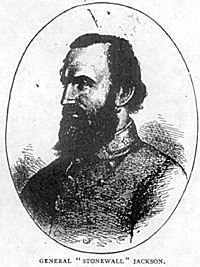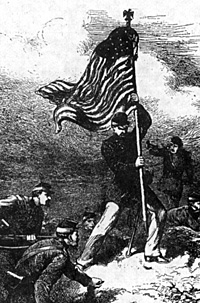
The American Civil War 1861-1865 was the greatest war ever fought on the-American Continent, between some of the largest armies ever assembled up to that time. It was the first of the modern wars, in which breech-loading rifled firearms were used and where telegraphs and railroads, for the first time, played a big part. Fought on the issues of slavery and the right of a State to secede from the Union, it caused father to fight son, brother to take up arms against brother so that the entire Nation was bitterley divided. It did not end until many great battles had been fought and more than 620,000 Americans had died from wounds and disease.
President Lincoln issued a call in April 1861 for 75,000 volunteers, to serve for a period of three months and this civilian army began training. By early July the Federal Government were becoming impatient, they wanted to see their troops in action - admittedly they were green but so were the enemy and the three-months volunteers had only a few more weeks to serve, morale would suffer if they went home without striking a blow. General McDowell was ordered to prepare a plan of attack - a great victory was required for the Fourth of July.
The General was at his wit's end - his troops were not even formed into brigades and he had no cavalry, many of his officers were political appointments and no one had had any experience of actual warfare. When the war had broken out and the officers of the Regular Army had had to declare their loyalties, by far the greater numbers and the most able had thrown in their lot with the South, including the greatest soldier of them all, Robert E. Lee of Virginia. Thus the Union forces lacked able leadership in addition to experience.
The Confederate forces had early realised the importance of Manassas, a small railroad junction only 25 miles from Washington, the Northern capital. By early June they were well established there in force and also had within reasonably easy reach another force under General Joe Johnson in the Shenandoah Valley, a few miles westward. So that the South had 23,000 men at Manassas under a flamboyant Creole, General Gustave Toussaint Beauregard, with a further 15,000 within call.
To oppose them, McDowell had about 28,000 men (his numbers were somewhat lessened before the battle began when various units, their three months period up, left for home!) Providing Johnson's force could be kept occupied in the Valley so that they did not reinforce Beauregard, McDowell felt that he could win. To keep Johnson busy in the Valley, the Union had sent an amiable antique of 69 years, General Patterson, who had been a dashing lieutenant in the war of 1812 and whose real qualification for command lay in his interest in politics and more money than anyone else in Philadelphia. Patterson completely failed to do his job and Johnson's Confederates were able to pull stealthily out and join Beauregard at Manassas, where his troops were strongly placed along the banks of a small creek - Bull Run.
Both armies had a gala air about them - amongst the Federal forces were gaily dressed Fire Zouaves in baggy red breeches and turbans, formed from the firemen of New York regiments were the Havelock Delmet with white neckpiece made popular by British forces in the recent Indian Mutiny, one New York regiment even wore kilts, whilst the South had their Louisiana Tigers, a regiment formed of French dock labourers from New Orleans who., being unable to find red cloth to make their Zouave breeches had made them from gay blue and white mattress ticking! The picnic atmosphere was further advanced by the presence of wagon-loads of spectators with their baskets of food and carriages containing politicians who made encouraging speeches to the raw soldiers as they sauntered along eating blackcurrants and emptying their cartridge boxes into the ditches as the hot sun made them too heavy to carry.
General McDowell had made his plans, which called for feint attacks on the enemy front whilst his main forces struck the enemy on the flank. In order to ascertain which flank would be the best for this operation, he ordered General Tyler to make a reconnaissance in force at Blackburn's Ford. So enthusiastically did Tyler carry out his orders that before he knew where he was, he had involved the bulk of his troops in a large scale clash with superior numbers of Confederates and he had been soundly beaten. This resulted in extreme depression in the Federal ranks with corresponding morale rises to the enemy.
 McDowell therefore decided that, as the enemy right flank was too strong, to send his
outflanking force to their left flank and, at daybreak on Sunday 21st July 1861, hours later
than planned, his soldiers made off on their outflanking march. General Tyler, who had suffered
the previous day's reverse, was ordered to make a feint attack over the central Stone Bridge,
but so half-heartedly was this carried out that it fooled no-one. Through seeing sunlight
glinting on bayonets, the Confederates discovered that they were being outflanked and reformed
their line to meet the threat. Nevertheless, they were beaten back to a high plateau where they
made a strong stand.
McDowell therefore decided that, as the enemy right flank was too strong, to send his
outflanking force to their left flank and, at daybreak on Sunday 21st July 1861, hours later
than planned, his soldiers made off on their outflanking march. General Tyler, who had suffered
the previous day's reverse, was ordered to make a feint attack over the central Stone Bridge,
but so half-heartedly was this carried out that it fooled no-one. Through seeing sunlight
glinting on bayonets, the Confederates discovered that they were being outflanked and reformed
their line to meet the threat. Nevertheless, they were beaten back to a high plateau where they
made a strong stand.
It was at this stage that General Bee, desperately trying to rally his Southern soldiers, glanced towards the stolidly formed troops of General Jackson and cried: "Look! There is Jackson standing like a stone wall!" Thus 'Stonewall' Jackson won his famous nickname.
The Federals made a bad blunder in ordering forward to an exposed position two crack artillery batteries composed of Regular soldiers. Confederate cavalry leader J.E.B.Stuart made a dashing cavalry charge and scattered the colourful Fire Zouaves escorting the guns, who came under a merciless musketry fire until, all the crews and horses killed, the guns were lost - an irreparable blow to the Federal forces.
The raw troops of both sides were fighting well and the battle raged to-and-fro until a brigade of Johnson's army -- from the Shenandoah Valley -- arriving late on the field, caused the Federal soldiers to imagine that large reinforcements were arriving and, having had enough, they turned round and in an ever-increasing mob, left the battlefield. Leaving arms, equipment, clothing, blankets, musical instruments lining the-road, the fugitives gave way to complete panic and they fled in a wild rout back to Washington.
Adding to the confusion were the throngs of sightseers in their carriages, Congressmen became lost as through the night and the rain the tide of soldiers and civilians streamed into Washington. Attempts by McDowell to rally his men proved to be in vain. The exhausted, battle-weary Confederates made no attempt at pursuit, although Stonewall Jackson begged to be allowed to try and capture Washington with 10,000 men - had he been permitted to do so the war would have taken a very different turn. As it was, the Federals of the North knew that this was not going to be so easy, the cheering stopped but recruiting doubled with no three month volunteers but men who put their names down to fight until the war ended.
Federal General Sherman, who took part in the battle, was later to remark that it was one of the best planned battles in history but the worst fought!
Back to Table of Contents -- Wargamer's Newsletter # 155
To Wargamer's Newsletter List of Issues
To MagWeb Master Magazine List
© Copyright 1975 by Donald Featherstone.
This article appears in MagWeb (Magazine Web) on the Internet World Wide Web.
Other military history articles and gaming articles are available at http://www.magweb.com